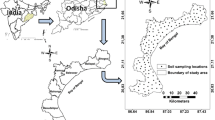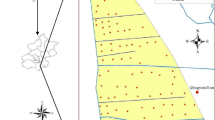Abstract
The Harran Plain is located in the southeastern part of Turkey and has recently been developed for irrigation agriculture. It already faces soil salinity problems causing major yield losses. Management of the problem is hindered by the lack of information on the extent and geography of the salinization problem. A survey was carried out to delineate the spatial distribution of salt-affected areas by randomly selecting 140 locations that were sampled at two depths (0 to 30 and 30 to 60 cm) and analyzed for soil salinity variables: soil electrical conductivity (EC), soluble cations (Ca2+, Mg2+, Na+, and K+), soluble anions (SO 2−4 , Cl−), exchangeable Na+ (me 100 g−1) and exchangeable sodium percentage. Terrain attributes (slope, topographical wetness index) were extracted from the digital elevation model of the study area. Variogram analyses after log transformation and ordinary kriging (OK) were applied to map spatial patterns of soil salinity variables. Multivariate geostatistical methods—regression kriging (RK) and kriging with external drift (KED)—were used using elevation and soil electrical conductivity data as covariates. Performances of the three estimation methods (OK, RK, and KED) were compared using independent validation samples randomly selected from the main dataset. Soils were categorized into salinity classes using disjunctive kriging (DK) and ArcGIS, and classification accuracy was tested using the kappa statistic. Results showed that soil salinity variables all have skewed distribution and are poorly correlated with terrain indices but have strong correlations among each other. Up to 65 % improvement was obtained in the estimations of soil salinity variables using hybrid methods over OK with the best estimations obtained with RK using EC0–30 as covariate. DK–ArcGIS successfully classified soil samples into different salinity groups with overall accuracy of 75 % and kappa of 0.55 (p < 0.001).







Similar content being viewed by others
References
Aydemir, S. (2001). Properties of palygorskite-influenced vertisols and vertic-like soils in the Harran Plain of Southeastern Turkey. Dissertation. TX, USA: Texas A&M University, College Station.
Aydemir, S., & Sonmez, O. (2008). Ameliorative effect of indigenous calcite on sodium-saturated clay sytems. Soil Science, 173, 96–107.
Andrews, S. S., Karlen, D. L., & Cambardella, C. A. (2004). The soil management assessment framework: a quantitative soil quality evaluation method. Soil Science Society of America Journal, 68, 1945–1962.
Bilgili, A. V., Akbas, F., & van Es, H. M. (2011). Combined use of hyperspectral VNIR reflectance spectroscopy and kriging to predict soil variables spatially. Precision Agriculture, 3, 395–420.
Bourennane, H., King, D., & Couturier, A. (2000). Comparison of kriging with external drift and simple linear regression for predicting soil horizon thickness with different sample densities. Geoderma, 97, 255–271.
Brouder, S. M., Hofmann, B. S., & Morris, D. K. (2005). Mapping soil pH: accuracy of common soil sampling strategies and estimation techniques. Soil Science Society of America Journal, 69, 427–442.
Bui, E. N., Smettem, K. R. J., Moran, C. J., & Williams, J. (1996). Use of soil survey information to assess regional salinization risk using geographical information systems. Journal of Environmental Quality, 25, 433–439.
Cambardella, C. A., Moorman, T. B., Novak, J. M., Parkin, T. B., Karlen, D. L., Turco, R. F., & Konopka, A. E. (1994). Field-scale variability of soil properties in Central Iowa soils. Soil Science Society of America Journal, 58, 1501–1511.
Cetin, M., & Kirda, C. (2003). Spatial and temporal changes of soil salinity in a cotton field irrigated with low-quality water. Journal of Hydrology, 272, 238–249.
Cullu, M. A. (2003). Estimation of the effect of soil salinity on crop yield using remote sensing and geographic information system. Turkish Journal of Agriculture and Forestry, 27, 23–28.
Dash, J. P., Sarangi, A., & Singh, D. K. (2010). Spatial variability of groundwater depth and quality parameters in the national capital territory of Delhi. Environmental Management, 45, 640–650.
Demir, Y., Ersahin, S., Güler, M., Cemek, B., Günal, H., & Arslan, H. (2009). Spatial variability of depth and salinity of groundwater under irrigated ustifluvents in the Middle Black Sea Region of Turkey. Environmental Monitoring and Assessment, 158, 279–294.
Douaoui, A. E. K., Nicolas, H., & Walter, C. (2006). Detecting salinity hazards within a semiarid context by means of combining soil and remote-sensing data. Geoderma, 134, 217–230.
Eldeiry, A. A., & Garcia, L. A. (2008). Detecting soil salinity in alfalfa fields using spatial modeling and remote sensing. Soil Science Society of America Journal, 72, 201–211.
ESRI. (2001). Using ArcGIS® Geostatistical Analyst. Redlands, CA, USA.
FAO/IUSS. (1998). World reference base for soil resources. Rome: Food and Agriculture Organization of the United Nations.
Florinsky, I. V., Eilers, R. G., & Leiyk, G. W. (2000). Prediction of soil salinity risk by digital terrain modelling in the Canadian Prairies. Canadian Journal of Soil Science, 80, 455–463.
Ghassemi, F., Jackeman, A. J., & Nix, H. A. (1995). Salinization of land and water resources: human causes, extent, management and case studies. Wallingford: CAB International.
Hengl, T., Rossiter, D., & Stein, A. (2003a). Soil sampling strategies for spatial prediction by correlation with auxiliary maps. Australian Journal of Soil Research, 41, 1403–1422.
Hengl, T., Heuvelink, G.B.M., & Stein, A. (2003b). Comparison of kriging with external drift and regression-kriging. Technical note, ITC. Available at http://www.itc.nl/library/Academic_output/. Accessed 5 December 2011.
Hengl, T., Heuvelink, G. B. M., & Rossiter, D. G. (2007). About regression-kriging: from equations to case studies. Computers & Geosciences, 33, 1301–1315.
Hesse, P. R. (1972). A textbook of soil chemical analysis. New York: Chemical.
Jordan, M. M., Pedreno-Navarro, J., Sanchez-Garcia, E., Mateu, J., & Juan, P. (2004). Spatial dynamics of soil salinity under arid and semi-arid conditions: geological and environmental implications. Environmental Geology, 45, 448–456.
Journel, A. G., & Huijbregts, C. H. J. (1981). Mining geostatistics. London: Academia.
Karlen, D. L., Tomer, M. D., Neppel, J., & Cambardella, A. (2008). A preliminary watershed scale soil quality assessment in north central Iowa, USA. Soil&Tillage Research, 99, 291–299.
Kendirli, B., Cakmak, B., & Ucar, Y. (2005). Salinity in the Southeastern Anatolia Project (GAP), Turkey: issues and options. Irrigation and Drainage, 54, 115–122.
Kravchenko, A. N., & Robertsen, G. P. (2007). Can topographical and yield data substantially improve total soil carbon mapping by regression kriging? Agronomy Journal, 99, 12–17.
Kozar, B., Lawrence, R., & Long, D. (2002). Soil phosphorus and potassium mapping using a spatial correlation model incorporating terrain slope gradient. Precision Agriculture, 3, 407–417.
Lark, R. M., & Ferguson, R. B. (2004). Mapping the conditional probability of deficiency or excess of soil phosphorous, a comparison of ordinary indicator kriging and disjunctive kriging. Geoderma, 118, 39–53.
Leenaers, H., Okx, J. P., & Burrough, P. A. (1990). Comparison of spatial prediction methods for mapping floodplain soil pollution. Catena, 17, 535–550.
Masoud, A. A., & Koike, K. (2006). Arid land salinization detected by remotely-sensed landcover changes: a case study in the Siwa region, NW Egypt. Journal of Arid Environments, 66, 151–167.
McBratney, A. B., Mendonça-Santos, M. L., & Minasny, B. (2003). On digital soil mapping. Geoderma, 117, 3–52.
Metternicht, G. I., & Zinck, J. A. (2008). Remote sensing of soil salinization: Impact on land management. Boca Raton: CRC.
Muhammad, S., Muller, T., & Joergensen, R. G. (2008). Relationships between soil biological and other soil properties in saline and alkaline arable soils from the Pakistani Punjab. Journal of Arid Environments, 72, 448–457.
Mueller, T. G., Pierce, F. J., Schabenberger, O., & Warncke, D. D. (2001). Map quality for site specific fertility management. Soil Science Society of America Journal, 65, 1547–1558.
Phachomphon, K., Dlamini, P., & Chaplot, V. (2010). Estimating carbon stocks at a regional level using soil information and easily accessible auxiliary variables. Geoderma, 155, 372–380.
Penizek, V., & Boruvka, L. (2006). Soil depth prediction supported by primary terrain attributes: a comparison of methods. Plant Soil and Environment, 52, 424–430.
Pozdnyakova, P., & Zhang, R. (1999). Geostatistical analysis of soil salinity in a large field. Precision Agriculture, 1, 153–165.
R Development Core Team. (2006). R: A Language and Environment for Statistical Computing. Vienna: R Foundation for Statistical Computing.
Richard, L. A. (1954). Diagnosis and improvement of saline and alkali soils. Washington, D.C.: United States Department of Agriculture. Hand book 60.
Seyrek, A., Aydemir, S., & Ince, F. (2005). Clay minerology of the slightly saline soils of the Harran Plain, South–East Turkey. Ataturk University Journal of Agriculture, 36, 137–144.
Shi, J., Wang, H., Xu, J., Wu, J., Liu, X., Zhu, H., & Yu, C. (2007). Spatial distribution of heavy metals in soils: a case study of Changxing, China. Environmental Geology, 52, 1–10.
Sorensen, R., Zinko, U., & Seibert, J. (2005). On the calculation of the topographic wetness index: evaluation of different methods based on field observations. Hydrology Earth System Sciences Discussions, 2, 1807–1834.
SPSS Inc. (1999). SPSS 10.0.6 for Windows, Chicago, IL.
Steenhuis, T. S., Bilgili, A. V., Kendy, E., Zaimoglu, Z., et al. (2006). Options for sustainable ground water management in arid and semi arid areas. In M. Kacira et al. (Eds.), Sustainable developments and new technologies for agricultural production in GAP region. Sanliurfa, Turkey, May 29–31, 2006.
Tanji, K. (2002). Salinity in the soil environment. In A. Lauchli (Ed.), Salinity: environment–plants–molecules (pp. 21–53). Dordrecht: Kluwer Academic.
Takata, Y., Funakawa, S., Akshalov, K., Ishida, N., & Kosaki, T. (2007). Spatial prediction of soil organic matter in northern Kazakhstan based on topographic and vegetation information. Soil Science and Plant Nutrition, 53, 289–299.
Triantafilis, J., Odeh, I. O. A., Warr, B., & Ahmed, M. F. (2006). Mapping of salinity risk in the lower Namoi valley using non-linear kriging methods. Agricultural Water Management, 69, 203–231.
USSLS. (1969). “Diagnosis and improvement of saline and alkali soils.” Agriculture Handbook United States Salinity Laboratory Staff. Washington: US Government Printing Office. no. 60.
Voltz, M., & Webster, R. (1990). A comparison of kriging, cubic splines and classification for predicting soil properties from sample information. J Soil Science, 41, 473–490.
Wackernagel, H. (2003). Multivariate geostatistics. New York: Springer.
Webster, R., & Oliver, M. A. (2007). Geostatistics for environmental scientists. Chichester: Wiley.
Wiebe, B. H., Eilers, R. G., Eilers, W. D., & Brierley, J. A. (2007). Application of a risk indicator for assessing trends in dryland salinization risk on the Canadian Prairies. Canadian Journal of Soil Science, 87, 213–224.
Wilding, L. P. (1985). Spatial variability: its documentation, accommodation, and implication to soil surveys. In D. R. Nielsen & J. Bouma (Eds.), Soil spatial variability (pp. 166–193). Wageningen: Pudoc.
Wu, J., Norvell, A., Hopkins, D. G., Smith, D. B., Ulmer, M. G., & Welch, R. M. (2003). Improved prediction an mapping of soil copper by kriging with auxiliary data for cation-exchange capacity. Soil Science Society of America Journal, 67, 919–927.
Yates, S. R., & Yates, M. V. (1988). Disjunctive kriging as an approach to management decision making. Soil Science Society of America Journal, 52, 1554–1558.
Zheng, Z., Zhang, F., Ma, F., Xurong, C., Zhu, Z., Shi, J., & Zhang, S. (2009). Spatiotemporal changes in soil salinity in a drip-irrigated field. Geoderma, 149, 243–248.
Zhu, Q., & Lin, H. S. (2010). Comparing ordinary kriging and regression kriging for soil properties in contrasting landscapes. Pedosphere, 20, 594–606.
Acknowledgments
The author are thankful to GAP Administration, The Scientific and Technological Research Council of Turkey (TUBITAK) and Scientific Research Administration of Harran University, Sanliurfa, Turkey (HUBAK).
Author information
Authors and Affiliations
Corresponding author
Rights and permissions
About this article
Cite this article
Bilgili, A.V. Spatial assessment of soil salinity in the Harran Plain using multiple kriging techniques. Environ Monit Assess 185, 777–795 (2013). https://doi.org/10.1007/s10661-012-2591-3
Received:
Accepted:
Published:
Issue Date:
DOI: https://doi.org/10.1007/s10661-012-2591-3




